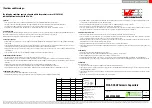
1.0
REV
2014-11-06
DATE
SSt
BY
PSL
CHECKED
Würth Elektronik eiSos GmbH & Co. KG
EMC & Inductive Solutions
Max-Eyth-Str. 1
74638 Waldenburg
Germany
Tel. +49 (0) 79 42 945 - 0
www.we-online.com
eiSos@we-online.com
DESCRIPTION
WCAP-CSGP Ceramic Capacitors
Order.- No.
885012008051
SIZE
A4
Size: 1206
1. General
•The capacitor is engineered, designed and manufactured to be used within the datasheet specified values.
•Do not use the capacitor neither short term nor long term outside the specified values, which are given in the data sheet.
•Do not apply any kind of flexural or compressive force onto soldered or unsoldered component.
•Prevent the capacitor surface from any damage or scratches with sharp edges (e.g. chassis, screwdrivers, pincers)
2. Product specific
The responsibility for the applicability of customer specific products and use in a particular customer design is always within the authority of
the customer. All technical specifications for standard products do also apply to customer specific products.
Follow all instructions mentioned in the data sheet, especially the following items:
2.1 Storage conditions
•These ceramic capacitors must be stored in stable conditions within an ambient temperature between 5°C to 40°C with a relative humi-
dity of <70%.
•The environment in which the capacitors are operated and stored has to have atmospheric characteristics and must be free of dew con-
densation and toxic gases (e.g. chlorine, ammonia, sulfur, hydrogen sulphide and hydrogen sulfate).
•All products shall be used before the end of the period of 12 months based on the product date code, if not, a 100% solderability cannot
be guaranteed.
•The capacitance tolerance as specified within the datasheet is only valid on the date of delivery.
2.2 Operating climatic conditions
•Do not exceed the lower nor the upper specified temperature under no condition.
•Be aware that the specified capacitance tolerance is only valid at the date delivery and according specified measurement criteria.
•Do not use the capacitors under high humidity, high temperature nor under high or low atmospheric pressure which may affect capacitors
reliability.
•Surface temperature including self-heating must be kept below the maximum operating temperature.
•The temperature rise of the capacitor´s temperature compared to ambient temperature shall be below 20°C.
•Avoid any water or heavy dust on capacitors surface, which may cause electrical leakage, damage, overheating or corrosion.
2.3 Operating load conditions
•Do not use the capacitor with any higher than specified voltage.
•Violation of the technical product specifications such as exceeding the specified voltage will void the warranty.
•Operating voltage across the terminals including AC and DC peaks and AC or pulse overshooting, Vp-p as well as irregular voltage becau-
se of resonance or switching must be below the rated voltage.
•Due to self-heating the reliability of the capacitor may be reduced, if high frequency AC or pulse is applied.
•Avoid any overload or conditions that are not specified in the capacitors datasheet.
•Consider carefully possible specific changes of electrical characteristics like capacitance over temperature, voltage and time as well as
the specific performance over frequency for the actual use conditions. For detailed information see datasheet.
2.4 Design of the P.C. board
•The chip capacitor shall be located to minimize any possible mechanical stress from deflection or board wrap.
•It is recommended to position the chip capacitor in parallel to slits and perforations and as far away from slits, perforations, separation
points, screw holes, frames and edges of the P.C. board to avoid mechanical stress.
•Determine the shape and size of the solder pads to have proper amount of solder on the terminations as the amount of solder at the ter-
minations has a direct effect on the reliability of the capacitor.
•Provide individual solder pads for each termination. Solder pads are specified in the datasheet.
•The PCB design (e.g. land pattern design and grounding planes) must be evaluated for each individual circuit to achieve the optimal sol-
dering results.
2.5 Mounting
•Avoid any stress from the mounting head to avoid cracks.
•Adjust the bottom dead center of the mounting head not to press on the P.C. board surface.
•The mounting head pressure has to be adjusted to 1 N up to 3 N of static force.
•Provide support from the bottom side of the P.C. board by a support pin for minimizing the impact energy from the mounting head.
•Provide sufficient close up dimension, preventive maintenance and replacement of the centering jaw to avoid a crack when it is worn out.
2.6 Adhesive
Selection of adhesive
•The adhesive should have sufficient coating and viscosity and should harden rapidly.
•The adhesive should be strong enough to hold parts on the board during the mounting and solder process and should have sufficient
strength at high temperatures.
•The adhesive should have corrosion resistance, excellent insulation characteristics and no emission of toxic gasses nor any effect on the
human body.
•Do not use too much adhesive to avoid pollution of the soldering pads.
I Cautions and Warnings:
The following conditions apply to all goods within the product series of WCAP-CSGP
of Würth Elektronik eiSos GmbH & Co. KG:
This electronic component has been designed and developed for usage in general electronic equipment only. This product is not authorized for use in equipment where a higher safety standard and reliability standard is especially required or where a failure of the product is reasonably expected to cause severe personal injury or death, unless the parties have executed an agreement specifically governing such use.
Moreover Würth Elektronik eiSos GmbH & Co KG products are neither designed nor intended for use in areas such as military, aerospace, aviation, nuclear control, submarine, transportation (automotive control, train control, ship control), transportation signal, disaster prevention, medical, public information network etc.. Würth Elektronik eiSos GmbH & Co KG must be informed about the intent of such usage before
the design-in stage. In addition, sufficient reliability evaluation checks for safety must be performed on every electronic component which is used in electrical circuits that require high safety and reliability functions or performance.
























